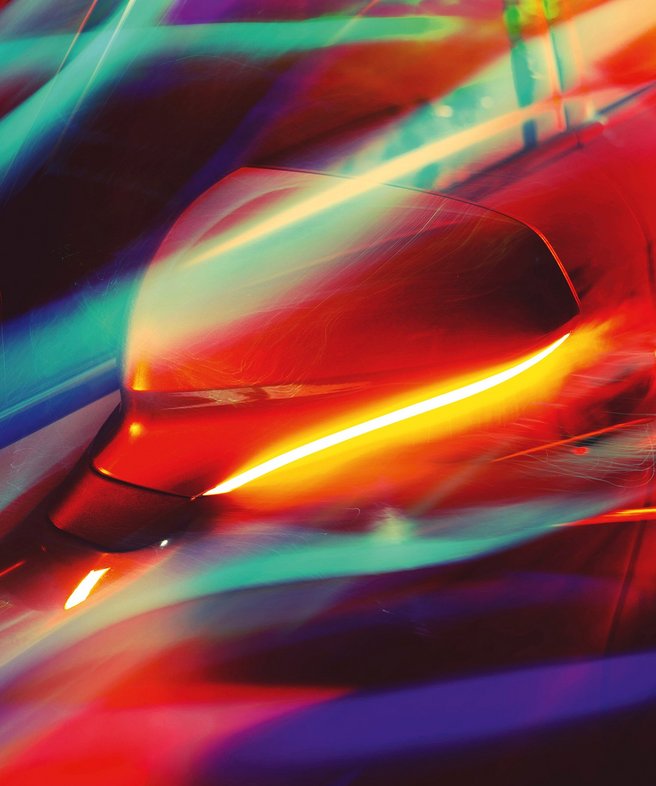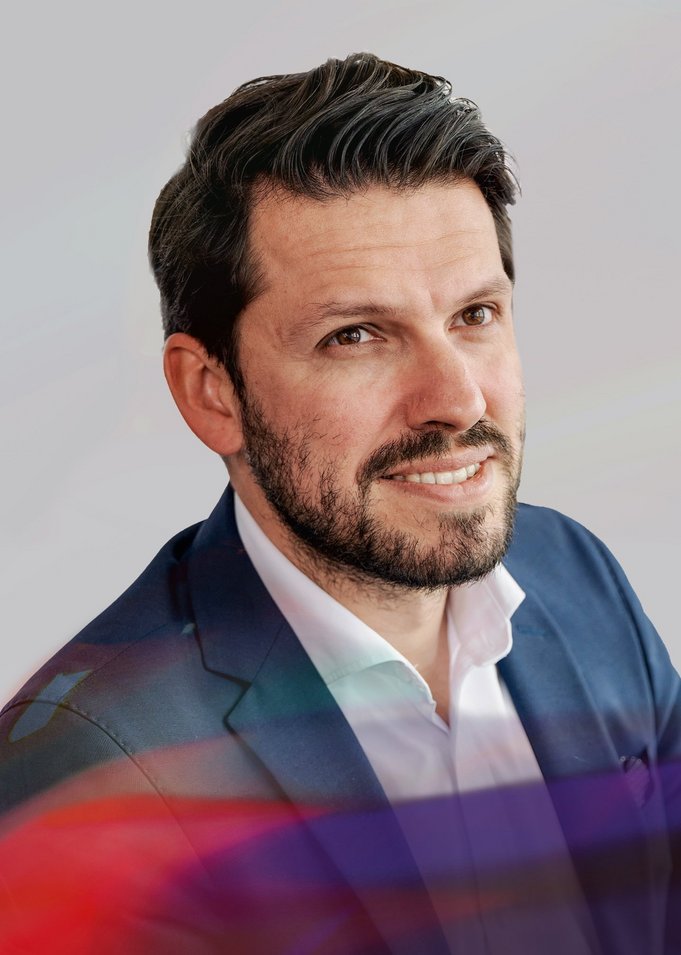OVER-THE-AIR OVERHAUL

A construction transporter is driving through unpaved terrain. So that the truck can handle the territory, the fleet manager books more engine power: very easily, with just the click of a mouse. When the job is done, he sets the engine back to its original factory settings—once back on regular roads, the engine has enough standard horsepower, which also uses less fuel on the normal routes. Functions that can be turned on and off as needed are also popular in regular passenger cars. For example, on a trip to the mountains for skiing in the family SUV, the all-wheel drive or seat heaters can be activated. Or a commuter upgrades her car with an autopilot function, taking off the strain of driving during rush hour. Updates transmitted to the vehicle over the air (OTA)—via the internet or a cellular connection—could make this possible, and these types of scenarios could become reality in just a few years.
“Over-the-air updates represent a true revolution for the automotive industry,” says Steffen Rilling, an automotive expert at the management consulting firm Oliver Wyman. Enormous benefits are expected for both manufacturers and drivers alike. For instance, vehicles wouldn’t have to be brought to the mechanic any longer to repair digital components. The owners aren’t the only ones who would save time and trouble. Expensive recalls for entire model series would become unnecessary if faults could be rectified after the fact via OTA updates. In addition, vehicles could be “rejuvenated” with new functions over their entire operating life, something smartphone and computer users have long been accustomed to. Even older used cars could be upgraded with new functions so long as the manufacturer maintains the model with updates.
„Over-the-air updates represent a true revolution for the automobile industry“
But is it really that easy to improve a vehicle with the click of a mouse? The most basic components—including the battery, engine, drivetrain, brakes and steering—can only be changed via software to the extent that the installed hardware allows. “To fully exploit this technology, vehicle models will have to be designed differently in the future than they have been in the past,” Rilling says. “In the past, vehicle manufacturers defined the performance requirements for a model and then looked to see which components they could use to implement these requirements as cost-effectively as possible. In the future, many car models will get higher-quality and more powerful hardware installed at the factory, even if this initially may not be utilized to its fullest extent. This way manufacturers are keeping the options for extensive updates open. This is a new way of thinking.” Economic considerations play an important role in this. The automotive industry is targeting digital business models, such as those familiar today from video streaming or software offerings: in the future, vehicle users will buy certain functions either through subscriptions or on demand. The industry hopes this will generate billions of euros in continuous revenues to supplement the already very lucrative after-sales business.
Over-the-air updates are already an everyday thing, particularly for electric vehicles and premium cars. Volkswagen recently used this method to equip its own ID series and electric models from its Audi, Skoda and Cupra subsidiaries with new Software 3.0, which enabled more charging power and a greater range for the battery, an improved voice control feature, and new graphics and indicators on the displays, among other things. For the Mercedes-Benz A class, an OTA update added some minor conveniences to the cockpit, including music streaming via Tidal and Amazon Music. Hyundai also provides its electric Ioniq 5 with maps and infotainment updates over the air, for example.
So far, such improvements have mainly been limited to purely digital applications. The reasons for this aren’t just technical. In Europe, the UNECE R156 regulation requires manufacturers to implement and certify a management system for software updates to obtain type approval. However, the increasing complexity of the software driving functions and the need for higher-frequency data processing are creating new challenges, making it necessary to revise existing processes for type approval and safety verification of vehicles. At TÜV SÜD, Head of Future Vehicle Technologies in Germany Christian Pahlke is researching new solutions to use virtual simulation methods to support the validation of safety-relevant OTA software updates. His goal is to establish legally recognized procedures for virtual homologation—the granting of approval by an official authority. This will also be of great importance for autonomous driving in the future. “With traditional processes, it would be challenging to realize homologation for autonomous vehicles at SAE Level 4 in an efficient and ongoing manner,” he says.

Safely into the future
Before a new vehicle model receives type approval and can be put out on the market in Europe, the manufacturer must have completed millions of test kilometers. This is the only way it can document that the vehicle is safe to drive in a wide variety of road and environmental conditions in almost every conceivable traffic scenario. Then, before the model can be officially approved, an expert opinion from technical service providers such as TÜV SÜD is also required. “This process also applies for safety-relevant OTA software updates,” Pahlke says. “But while new vehicle models are only introduced to the market and have to be homologated every three to six years, OTA updates are expected at a frequency of every few weeks or months in the future. That’s why we need a new, accepted and recognized homologation approach for validating safety-relevant OTA software updates between manufacturers, technical service providers and regulatory authorities. These procedures must be both as fast and as dependable as possible.”
This is exactly what TÜV SÜD is researching right now. “The homologation process itself will remain, however some process stages are to be automated or digitized,” Pahlke says. While some tests must still be physically carried out, he notes: “The bulk of the safety-relevant software updates could be simulated and tested. Aside from leading to quicker and more efficient findings, this also makes it possible to check the enormous variance and complexity.” Furthermore, the main vehicle inspection will also need to be updated and expanded to include test criteria that do justice to the digital inner workings of current and future vehicles.
“Without an effective approach to virtual homologation of software updates, it will be very difficult to implement future vehicle innovations.”

Establishing suitable testing and approval procedures is just one of the major hurdles on the path to a constantly updatable vehicle. There are also major technical problems that manufacturers must solve in vehicle architectures. Electronic controls and digital functions in vehicles have been on the rise since the 1990s, but the overall process has been somewhat haphazard. “There are an estimated 100 million lines of software code in a vehicle today,” automotive expert Rilling explains. “However, they are distributed among about a hundred different control units. This enormous complexity makes it very difficult to efficiently update multiple functions at the same time with a single update. Manufacturers will only be able to get a handle on this through a centralized system. Like smartphones, vehicles need an overarching operating system to which all the other software application can dock.”
Some automakers purchase these technologies from partners, for instance the Android system from Google, which now has a version especially for vehicles. Other manufacturers, such as Volkswagen, BMW and Mercedes-Benz, make the effort to develop their own operating systems. “This has the advantage for them that they can supply this important interface to the customer themselves and integrate it into their own value chain,” Rilling says. “Carmakers today are faced with the challenge of also having to become software companies. Their future viability depends on it. For them, this transformation is even more far-reaching than the switch from traditional combustion engines to the new alternatives.”
A great deal is expected of the car of the future. It should be able to drive itself, recognize and avoid dangers, and always be up to date in terms of functionality and safety via over-the-air software updates. The feature that could make all of this possible is called connectivity. The vehicle’s connection to its environment via sensors, mobile communications and the internet is a prerequisite for highly automated driving and for the OTA updates. “Connectivity is both an opportunity and a threat because it is also a safety risk for vehicles,” TÜV SÜD’s Christian Pahlke says. “Even comparatively non-critical systems such as infotainment can be a gateway through which cyberthugs could hack a vehicle’s safety-relevant functionality.” To ensure the safety of vehicles in the future, the TÜV SÜD expert is currently focusing on the development of automated and digital process steps for homologating vehicle software. “Due to the topic’s complexity, we can only take a step-by-step approach to developing the right solutions.”